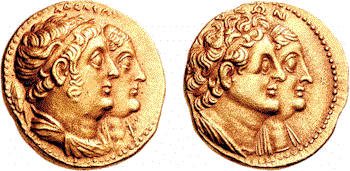Son of Ptolemy
I who consolidated Alexandria's control of Palestine & north
Africa and developed it as a major center of Greek culture. Yet, in politics Ptolemy II was less influenced by
Greek tradition than the Egyptian cult of the Pharaohs. Not only did he
promote the worship of his deceased parents as gods, he also portrayed
himself & his sister consort as sibling deities [theoi adelphoi]. The ruler cult that he actively sponsored was mimicked by
later Seleucid [e.g., Antiochus
III & IV]
& Roman rulers [e.g., Caligula
& Nero] as well as by his
own descendents.
At age 18 (290
BCE) Ptolemy was made his
father's co-regent in order to guarantee his succession. After his father
died (283
BCE),
Ptolemy repudiated his first wife, married his older
sister--Arsinoe II--&
made her co-regent of his empire (277
BCE). To celebrate their status as
sibling co-rulers, brother & sister both adopted the epithet Philadephus
["brother/sister loving"].
Like his father, Ptolemy II was a shrewd
diplomat. Though his military ventures met with mixed results, he
compensated for any losses on the battlefield by arranging strategic
marriages that turned rivals into in-laws. He
was also an effective administrator, reorganizing the Egyptian economy to
establish a period of great prosperity, at least for the urban ruling
& mercantile classes. To promote trade with the Orient he had a
canal constructed to link the Nile to the gulf of Suez. Under his rule the building projects his
father had initiated [the lighthouse & library] were completed & the Museion
became a center for Greek education rivaling the
schools of Athens. Jewish sources credit him with sponsoring the
translation of the Hebrew Torah into Greek, a project that hastened the
Hellenization of Jews & opened Jewish scriptures to Gentiles.
The legend that this work was accomplished by
seventy scribes, led the Greek translation of the Jewish scriptures to be
dubbed the Septuagint [70].
Ptolemy II extended his Hellenizing
projects into Palestine by transforming ancient Semitic centers into Greek
cities. Rabbah in Jordan [now Amman] was rebuilt as Philadelphia; Akko on the
Phoenician coast became PtolemaÔs
-- both named in honor of himself. Since Ptolemy II made no overt attempt
to Hellenize Jerusalem or Judea, however, later Jewish tradition portrayed
him as a benefactor.
References: Josephus,
Antiquities 12.11-13, 45, 51, 58-86, 106, 118.
______, Apion 2.45-47.
Pausanias, Description
of Greece
1.6.8-7.3,
8.6.
Other resources on line:
![]()
![]()

![]()
![]()
![]() Perspective on the
World of Jesus
Perspective on the
World of Jesus ![]()